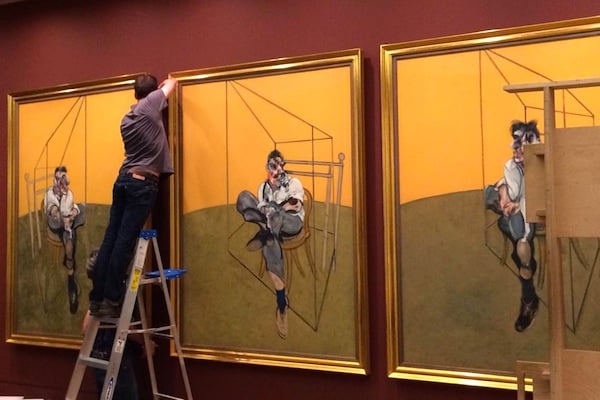Art World
The Essentials: How Artists and Collectors Avoid Taxes, Rescuing Looted Antiquities on Twitter, and More Art News to Start Your Week
Plus art history's top 10 male nudes, a show of Nicolas Cage artworks, and more.

Plus art history's top 10 male nudes, a show of Nicolas Cage artworks, and more.

The Double-Feature: As the deadline for Americans to file their 2013 taxes looms—April 15, folks!—the Atlantic and the New York Times looked into a couple of art-related tax schemes. In Mexico, the Atlantic discovers, artists can pay their taxes in art. While the country has lost an astounding $872 billion to money laundering and tax evasion during the past 40 years, it has also amassed a collection of more than 7,000 sculptures, paintings, and works on paper thanks to its “Pago en Especie” (“Payment in Kind”) initiative. “You might think we would be tempted to scribble something on a napkin to pay our taxes,” Mexico City-born painter Miguel Calderón—whose Leon Golub-like works featured prominently in Wes Anderson’s film The Royal Tenenbaums—told the Atlantic. “But aside from being convenient, it is also a source of pride, knowing that your art will become part of a historic collection that reflects Mexico’s creative heritage.”
For those of us living north of the border, and who have recently acquired very expensive artworks, loaning them to museums in select states including Oregon, New Hampshire, and Delaware means that no taxes will have to be paid on those purchases, the New York Times reports. This loophole no doubt partly explains why Elaine Wynn loaned the Francis Bacon triptych she bought for $142 million to the Portland Art Museum. “The two museums, the Portland Art Museum and the Jordan Schnitzer Museum of Art, are the beneficiaries of getting amazing works of art that they would not get,” the collector Jordan Schnitzer, whose multimillion-dollar donations put his name on the Eugene museum, told the Times.
The Interview: As she and her husband Ilya Kabakov prepare for one of their most high-profile commissions ever—Monumenta 2014, which takes over Paris’s Grand Palais next month—Emilia Kabakov sheds light on the nature of the pair’s collaboration, her departure from the Soviet Union, her love of books, and her recent conversion to reading on an iPad. “I am crazy about books and I’m getting more crazy about them,” she tells the Telegraph. “We have a huge collection of physical books, but now I’ve started buying them on my iPad.”
The Behind-the-Scenes Feature: Staff at the Fogg Museum, Busch-Reisinger Museum, and Arthur M. Sackler Museum are preparing for the November reopening of the Harvard Art Museums following a six-year, $350-million expansion and renovation that will connect all three institutions under a master plan signed by Renzo Piano. As the rehanging commences, the Boston Globe takes a look at the process of fitting the refurbished galleries with art—and illustrates the changes in a handy infographic. “Until all of the art is installed, it’s still a kind of empty vessel,” Harvard Art Museums director Tom Lentz tells the Globe. “A beautiful, empty vessel but not complete.”
The Profile: Monica Hanna is using social media and advocacy to ensure the return of works looted from historical sites in Egypt and the Malawi National Museum. “Egyptian history is being destroyed,” Hanna told the New York Times. “We need a worldwide collective effort.”
The Eye Candy: Hummingbirds, a new book by Michael Fogden and Marianne Taylor, features stunning life-size pictures of 262 of the 338 known species of hummingbirds. “They’re very agile, and they do change direction very rapidly, but they don’t actually go very fast,” Fogden told the Wall Street Journal, which included 12 of them in this slideshow.

Detail of Donatello’s David at the Bargello Palace and Museum in Florence.
Photo: Patrick A. Rodgers. Via Wikimedia Commons.
The Exxxtra Eye Candy: With nothing more pressing on his plate, Jonathan Jones continues to publish insipid, insular, and uninspired lists on his Guardian blog counting down his top 10 [insert category here] in art, this week focusing in on male nudes. “No modern image is more blatantly sexual than Donatello’s 15th-century statue of a naked youth, his smooth flesh set off by tight boots as he rests a foot in the soft hair of the slain Goliath,” Jones writes in reference to the Italian artist’s rendering of David. “Androgynous and overtly teasing, it makes you self-conscious to look too long at this magnetic work in the Bargello Museum, in Florence.”
The Review: Ariella Budick, reviewing “When the Stars Begin to Fall: Imagination and the American South” at the Studio Museum in Harlem for the Financial Times, writes that curator Thomas “Lax has stacked the deck: although he has brought in establishment figures such as Carrie Mae Weems and Kerry James Marshall, too often the sculptures, drawings and assemblages of the self-taught manage to trump the polished products of their more educated colleagues.”
The How-To: Ellen Gamerman of the Wall Street Journal takes a close look at the market for seemingly affordable etchings, drawings, and cast-off doodles by the likes of Rembrandt, Degas, Renoir, Warhol, and other giants of art history, finding more than a little cause for concern when it comes to the works’ authenticity. “Some of these things are indeed becoming financially valuable because they are praised by a growing number of ill-informed collectors,” the Giacometti Foundation’s former director, Véronique Wiesinger, comments. “It no doubt reflects a loss of connoisseurship, from collectors and auction specialists.”
The Controversy: Teodoro Nguema Obiang Mangue, the vice-president of Equatorial Guinea—whose father, Teodoro Obiang Nguema Mbasogo, has been president since 1979—is being investigated in France on charges of money-laundering and stands accused of leveraging his nation’s natural resources to spend some $104 million on the collection of Impressionist artworks by Chagall, Matisse, Toulouse-Lautrec, Monet and others that adorned his Parisian home, Mediapart reports (via Art Market Monitor).

A lonely chair at CERN.
Courtesy Lonely Chairs at CERN, via Tumblr.
The Tumblr Project: Guardian blogger Jon Butterworth points us to the weirdly engrossing Tumblr blog “Lonely Chairs at CERN,” a running catalogue of the solitary seats at the site of the Large Hadron Collider.
The List: My favorite “treasure” on the Telegraph‘s delightful list of ten valuable objects uncovered by the reality TV program “Antiques Roadshow” is the half-smoked cigar that Winston Churchill was chewing on as he planned D-Day. It was valued at £800 ($1,337).
The WTF: Amid this weekend’s Masters golf tournament in Augusta, Georgia, the city was plastered with anti-Barack Obama street art placards emblazoned with hilarious golf pun slogans like “Sub Par” and “If You Like Your Handicap, You Can Keep Your Handicap,” the American Thinker reports.

A painting from the “Nicolas Cage Art Show.”
Via Facebook.
The Extra WTF: As in last week’s edition of The Essentials, we are once again highlighting the artistic achievements of Nicolas Cage, this time by way of the exhibition “Nicolas Cage, Art Show,” which went down this weekend in San Francisco. “The ‘Nicolas Cage Art Party’ (alternately called the Nicolas Cage Art Show and Musical Shenanigans) is the brainchild of Ezra Croft,” writes Mashable’s Sam Laird. “Croft is 35 years old, a Burning Man veteran, an avid cyclist, and a Bay Area DJ who works at Bed Bath & Beyond to pay the bills.”
The Extra-Curricular: The New York Times profiled Katie Longmyer, a self-labeled “business artist,” who connects musicians and DJs with brands and labels, delivering the underground icons of youth culture to very above-ground companies like Warner Brothers and Jaguar. “The most prickly artists in the industry who don’t like anyone corporate, they trust Katie,” WB’s Andie Brokaw Simon tells the Times. “She doesn’t think about how to be global. She doesn’t believe the hype, even if it’s her own hype.”